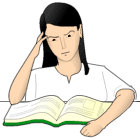Reading involves interpreting what the author has written. You will be making sense of the words on the page. You too will be making meaning.
To maximize your reading productivity and effectiveness you will need to determine:
- your purpose for reading the text
- which reading approach is best suited to your purpose
Although you may be aware of the purpose of your reading, it is even
more important that you know how
to read effectively. This may sound a little silly given that you
are reading this right now!
The answer to this question involves more than simply recognizing the correct sequence of letters, words, sentences and so on. It concerns the various ways in which you might access and process the words that you are recognizing.
It is important to adapt your reading approach to suit the material and your purpose. Reading approaches can be separated into two styles which are suited to different purposes as outlined in the table below:
fast reading |
slow reading |
• separate irrelevant from relevant information |
• gain a detailed understanding of material |
• gain an overview of the material |
• evaluate what you have read |
• locate specific information |
• maintain your concentration |
| • identify central themes or ideas | • remember exactly what you have read |
• follow instructions or directions |
|
| • understand difficult terms or ideas |
If you need to understand the terms, specific directions, or to remember what you have read then an analytical reading approach is needed. Analytic reading involves reading in an active and systematic way so that you gain an understanding of what you are reading.
One technique for analytic reading involves enhancing your understanding of what you read by recognising the level of information that it contains. This involves three levels of recognition:
 |
1. what does the writer say? |
| 2. what does the writer mean? | |
| 3. how do I connect this with what I already know or need to know? |
If you need to evaluate the material then a critical reading approach might be appropriate. Critical reading involves exercising your judgment about what you are reading. It involves you evaluating the arguments or positions presented by the writer. You ask questions of the claims or statements made by the author, and then seek to provide answers for those questions.
Common questions include:
- what is the evidence for this argument?
- do I agree with it?
- if so, what is my evidence for agreement?
- if not, what is my evidence to counter the author's argument?
- what alternative perspectives are possible here?